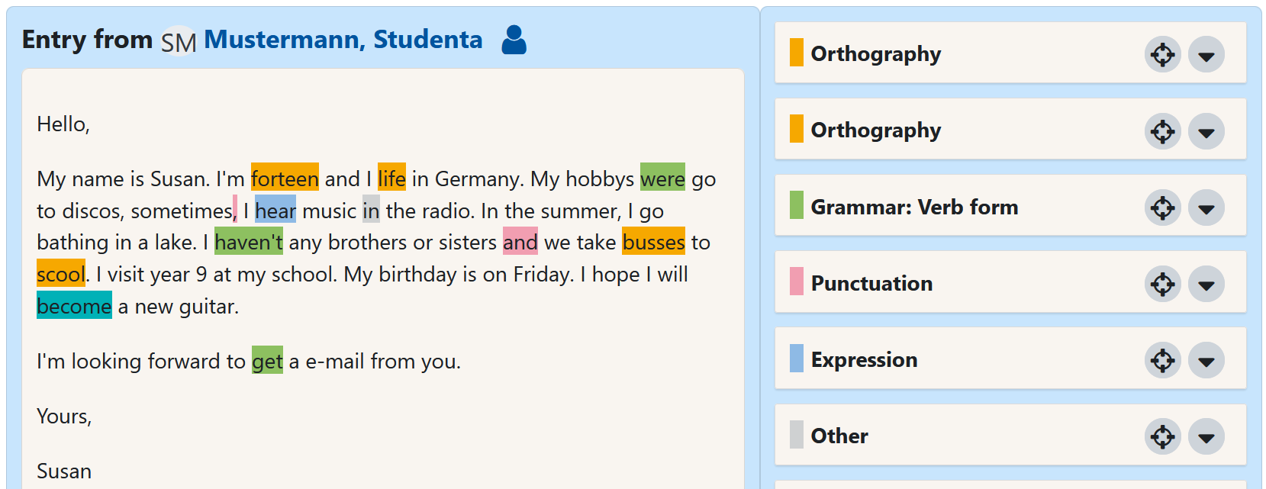General info on Margic activity

Hint
The Margic activity offers students the opportunity to create text entries in RWTHmoodle, which can then be annotated and evaluated by lecturers. Margics can be helpful in language teaching, for example. Students submit texts they have written themselves, which are then annotated by the lecturer according to predefined grammatical and spelling error types. The texts created in Margic are only visible to the respective authors and teachers, but not to fellow students.

Contents
- What is a Margic activity?
- Are there other activities in Moodle that allow annotations and how do they differ from Margic?
- Core functions of Margic
- Tips and tricks

With the Margic activity, students can create and submit extensive texts directly in Moodle. Lecturers can then view, correct and evaluate the submitted text entries on a customizable overview page. Lecturers can mark specific text passages and write comments on them, whereby an error type and a short text can be stored for each comment. The entire entry can also be graded and provided with text or audio feedback.

The error types that are available for the annotations can be flexibly adapted. For this purpose, each error type is assigned its own color, which can be used to visually distinguish the annotations from one another. In an error overview, lecturers can also evaluate for each student how many and which errors were made in a Margic. It is also possible to export or print out the entries of a Margic for further use.
2. Are there other activities in Moodle that allow annotations and how do they differ from Margic?
In addition to Margic, there are two other activities in RWTHmoodle with which annotations are possible. These can be clearly distinguished from each other in terms of their possible uses and range of functions:
2.1. PDF Annotations

With the "PDF annotation" activity, students can add questions, notes and comments to a PDF document. The students do not submit their own text entries or documents but annotate the PDF documents provided by the lecturers. In addition, the PDF annotator follows a collaborative approach in which all participants in a course room make annotations to a PDF document together, which are then visible to all participants in a course room and can be replied to. Annotations in Margic, on the other hand, are reserved exclusively for lecturers and are only visible to students who submitted the respective text entries.
2.2. Assignment Activity

The assignment activity enables students to submit solutions to assignments, which the lecturers then annotate and evaluate. The submission can either be in the form of a file (e.g. as a PDF) or as text input directly in Moodle. The lecturers then annotate in different ways depending on the type of submission: directly in the submitted PDF file or in a comment field that enables direct editing of the original text input. The second option in particular has some similarities to the Margic activity. However, the task activity does not allow the specification of customizable error types that can be used for annotation. As a result, there is also no error overview with automatic evaluation that allows lecturers to see how many and which errors have been made. The Margic activity is therefore preferable to the Task activity if the annotations are to be made with certain predefined error types. Group submissions with joint submission of solutions by several students, on the other hand, are only possible with the task activity. Margic does not offer the option for group submissions.
- Composing and editing text and multimedia entries
- Individually customizable overview page with all existing entries in Margic
- Extensive annotation and evaluation options for lecturers
- Customizable annotation types and detailed error evaluation
The predefined list of available error types for the annotations can be flexibly adapted so that Margics can also be used in a wide range of other teaching and learning scenarios in addition to language teaching. Lecturers can also use an annotation or error summary to evaluate how many and which errors the individual participants have made in a Margic. Participants also have the opportunity to revise their original entry in Margic and use the feedback they receive to improve it. This enables an iterative editing and improvement process.

Further information:

